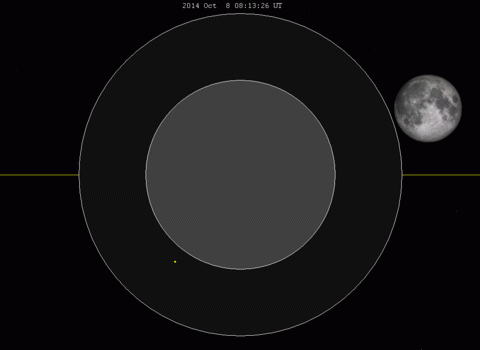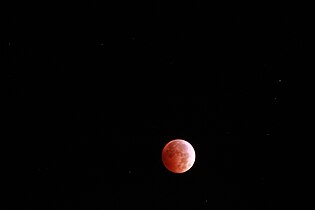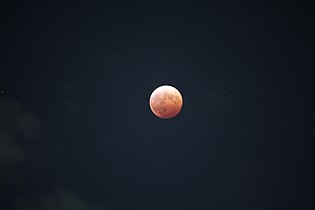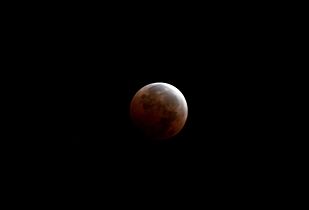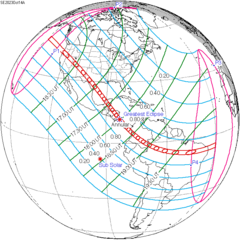|
October 2014 lunar eclipse
A total lunar eclipse occurred at the Moon’s descending node of orbit on Wednesday, October 8, 2014,[1] with an umbral magnitude of 1.1670. A lunar eclipse occurs when the Moon moves into the Earth's shadow, causing the Moon to be darkened. A total lunar eclipse occurs when the Moon's near side entirely passes into the Earth's umbral shadow. Unlike a solar eclipse, which can only be viewed from a relatively small area of the world, a lunar eclipse may be viewed from anywhere on the night side of Earth. A total lunar eclipse can last up to nearly two hours, while a total solar eclipse lasts only a few minutes at any given place, because the Moon's shadow is smaller. Occurring about 2.2 days after perigee (on October 6, 2014, at 5:40 UTC), the Moon's apparent diameter was larger.[2] This lunar eclipse is the second of a tetrad, with four total lunar eclipses in series, the others being on April 15, 2014; April 4, 2015; and September 28, 2015. BackgroundA lunar eclipse occurs when the Moon passes within Earth's umbra (shadow). As the eclipse begins, the Earth's shadow first darkens the Moon slightly. Then, the shadow begins to "cover" part of the Moon, turning it a dark red-brown color (typically - the color can vary based on atmospheric conditions). The Moon appears to be reddish because of Rayleigh scattering (the same effect that causes sunsets to appear reddish) and the refraction of that light by the Earth's atmosphere into its umbra.[3] The following simulation shows the approximate appearance of the Moon passing through the Earth's shadow. The Moon's brightness is exaggerated within the umbral shadow. The southern portion of the Moon was closest to the center of the shadow, making it darkest, and most red in appearance. The planet Uranus was near opposition (opposition on 7 October[4]) during the eclipse, just over 1° from the eclipsed Moon. Shining at magnitude 5.7, Uranus should have been bright enough to identify in binoculars. Due to parallax, the position of Uranus relative to the Moon varied significantly depending on the viewing position on the surface of Earth. Visibility and appearance The eclipse was completely visible over northeast Asia, eastern Australia, the Pacific Ocean, and western North America, seen rising over Asia and much of Australia and setting over North and South America.[5] The eclipse was visible in its entirety over the Northern Pacific. Viewers in North America experienced the eclipse after midnight on Wednesday, October 8, and the eclipse was visible from the Philippines, western Pacific, Australia, Indonesia, Japan, and eastern Asia after sunset on the evening of October 8. Many areas of North America experienced a selenelion, able to see both the sun and the eclipsed moon at the same time.[6] The MESSENGER spacecraft from orbit at the planet Mercury which was 107 million kilometers away from Earth at the time also observed the eclipse, making it the first lunar eclipse in history to be observed from another planet.[7][8]
Timing
† The Moon was not visible during this part of the eclipse in this time zone. 
GalleryWikimedia Commons has media related to Lunar eclipse of 2014 October 8.
Eclipse detailsShown below is a table displaying details about this particular solar eclipse. It describes various parameters pertaining to this eclipse.[10]
Eclipse seasonThis eclipse is part of an eclipse season, a period, roughly every six months, when eclipses occur. Only two (or occasionally three) eclipse seasons occur each year, and each season lasts about 35 days and repeats just short of six months (173 days) later; thus two full eclipse seasons always occur each year. Either two or three eclipses happen each eclipse season. In the sequence below, each eclipse is separated by a fortnight.
Related eclipsesEclipses in 2014
Metonic
Tzolkinex
Half-Saros
Tritos
Lunar Saros 127
Inex
Triad
Lunar eclipses of 2013–2016This eclipse is a member of a semester series. An eclipse in a semester series of lunar eclipses repeats approximately every 177 days and 4 hours (a semester) at alternating nodes of the Moon's orbit.[11] The penumbral lunar eclipse on May 25, 2013 occurs in the previous lunar year eclipse set, and the penumbral lunar eclipse on August 18, 2016 occurs in the next lunar year eclipse set.
Saros 127Lunar saros series 127, repeating every 18 years and 11 days, has a total of 72 lunar eclipse events including 54 umbral lunar eclipses (38 partial lunar eclipses and 16 total lunar eclipses). Solar Saros 134 interleaves with this lunar saros with an event occurring every 9 years 5 days alternating between each saros series.
Half-Saros cycleA lunar eclipse will be preceded and followed by solar eclipses by 9 years and 5.5 days (a half saros).[12] This lunar eclipse is related to two annular solar eclipses of solar saros 134.
See alsoReferences
|
|||||||||||||||||||||||||||||||||||||||||||||||||||||||||||||||||||||||||||||||||||||||||||||||||||||||||||||||||||||||||||||||||||||||||||||||||||||||||||||||||||||||||||||||||||||||||||||||||||||||||||||||||||||||||||||||||||||||||||||||||||||||||||||||||||||||||||||||||||||||||||||||||||||||||||||||||||||||||||||||||||||

